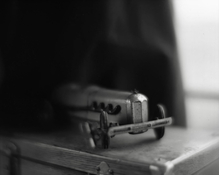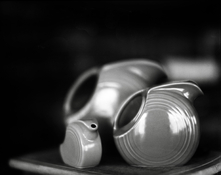Fujinon 5.6/250 SF
Regarding post #42: The Fujinon 5.6/250 SF (Soft Focus) might be the lens you were asking about.
The Fujinon 5.6/250 SF is a modified Cooke triplet that’s quite soft wide open. These are mounted in a Copal 3S shutter. It’s softness is variable from f/5.6 and is fully sharp by about f/11 or so. Of course, altering the aperture also varies the depth of field. It’s most used for soft focus portraits and misty-renditions of landscapes and so forth on the 4” x 5” and 5” x 7” formats.
It has a 300 mm infinity-focus image circle and 58º coverage angle. It will cover the 314 mm diameter diagonal of an 8” x 10” holder beginning at magnification m = 0.133X (subject distance of 19 meters and closer).
The Fujinon SF lenses are originally supplied with two modifying discs—Fuji called then “grids”—that attach to the rear of the front cell. The front cell is easily unscrewed from the barrel for grid changes. The lens is useable with either of the two grids, or without a grid attached, depending on the effect you want.
https://www.pacificrimcamera.com/rl/00910/00910.pdf
The following was transcribed from a Fuji SF lens data sheet:
How to use Fujinon SF lenses
“ The spherical aberration of these lenses has been retained to enable them to produce the desired effects. Thorough acquaintance with the effects they will produce is therefore necessary in order to make the most of what they can offer because the picture will turn out differently depending on how they are focused or defocused as well as on the aperture used and on whether or not the picture is taken with the grid on or off and the type of grid used.
Focusing
The intended effects may not be possible if the lens is first focused with the aperture fully open then afterwards closed down to take the picture. The correct focusing procedure is outlined below.
1. Focusing the lens with the aperture set for exposure. With soft focus lenses the case is not the same as other type of lenses in terms of focusing. It is advisable to adjust lens while watching the soft effect it will produce.
2. Focusing the lens with the aperture closed down. The aperture is set for exposure then closed down by 1 or 2 stops for focusing the lens on a vital point of the picture, e.g. on the catchlight in the case of portraits. The aperture is then reset for making the exposure.
How to use grid
The grid enables the Fujinon SF Lenses to yield maximum soft effect picture
1. To mount a grid on the lens
2. Normally, the standard soft effect is produced at F9 using the Yellow grid or F10 using the Red grid
3. The grid requires the use of aperture differing from those for normal aperture.”









